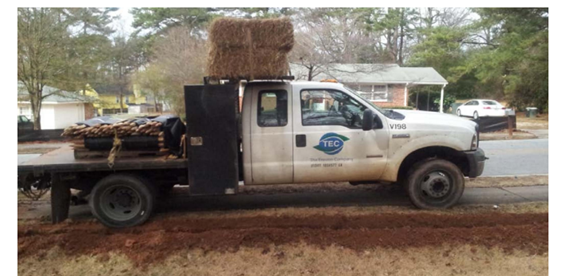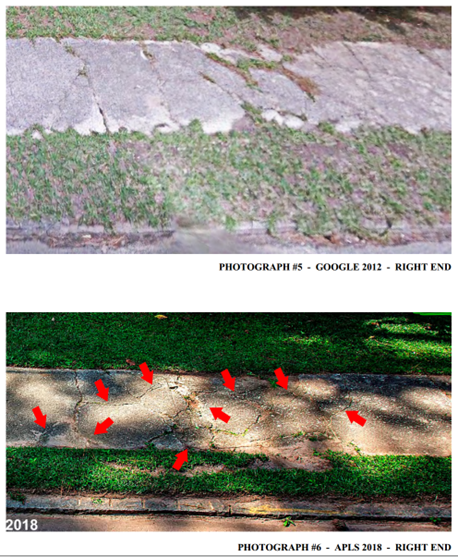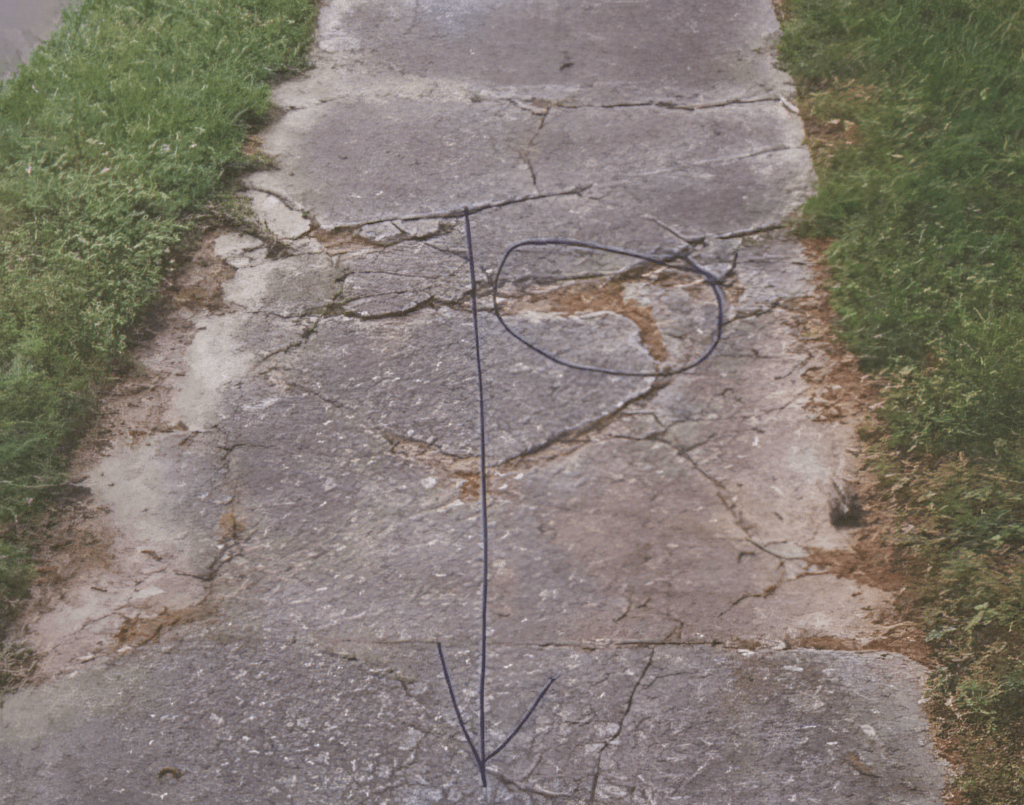Avoiding Cracks in Your Sidewalk Case
Posted by Wetherington Law Firm | Pedestrian Accidents
- Articles
- Artificial Intelligence
- Car Accidents
- Class Action Lawsuit
- Comparative Negligence
- Crime Victim
- Defective Vehicles
- Disability
- Kratom Death and Injury
- Legal Marketing
- Motor Vehicle Accidents
- News/Media
- Other
- Pedestrian Accidents
- Personal Injury
- Results
- Sexual Assault
- Truck Accidents
- Uber
- Wrongful Death
Categories
Avoiding Cracks in Your Sidewalk Case
By: Matt Wetherington
June 1, 2023
Sidewalks are the unsung heroes of our society. And that’s not just puffery for this article. Sidewalks play a crucial role in facilitating social interactions, enhancing safety, and promoting overall well-being. They provide pedestrians with safe walkways separated from traffic, resulting in fewer accidents and promoting healthier lifestyles. However, poor design can lead to deadly interactions with cars and poor maintenance can lead to serious injuries on the sidewalks themselves. This article will explore the legal uniqueness of sidewalks, delving into the shared public and private responsibilities of governments, landowners, and pedestrians.
Duty: The Foundation of Your Case
Everyone knows that property owners have a duty to maintain their property in a reasonably safe condition. But applying this principle to sidewalks can be more complicated than expected because of the public/private nature of sidewalks. The duties and notice standards change based on the property owner, the location of the sidewalk, and the status of the injured person. In urban areas, the responsibility for sidewalk maintenance typically falls on the municipality or city where the sidewalk is located. However, some cities, like Atlanta, have ordinances that shift the responsibility to adjacent property owners. In rural areas, the responsibility more commonly falls on the property owner adjacent to the sidewalk. Finally, if the sidewalk is on a state highway, the Georgia Department of Transportation (GDOT) may assume responsibility for maintenance. This issue gets even more complicated when all parties involved disclaim responsibility. Thus, when in doubt, your first step should be to notify every potential party of your claim. This includes the property owner, neighborhood association, city, county, and state.
Municipalities
As a basic starting point, municipalities are responsible for maintaining public sidewalks. However, liability for hazardous conditions is governed by statute. Pursuant to OCGA § 32–4–93(a), a municipality is absolved from liability due to a defect in a public road or sidewalk when it does not have actual notice of such a defect, or when the defect has not existed for a long enough period for the city to be reasonably expected to have noticed it. Thus, a municipality must have either created the condition, had some form of notice of the condition, or it must have existed for a sufficient length of time for notice thereof to be inferred. The duty to maintain is ministerial in nature and the standard ante litem notice is required. Importantly, the obstruction or defect must be in an area meant for pedestrian traffic. Even if the city maintains an area as part of sidewalk maintenance, if that area isn’t actually a designated walkway, the city may not be held liable for it.
There are two caveats that expand and restrict municipal liability for sidewalk hazards. First, a city’s obligation to maintain safety even extends to state highway portions within its limits if it has agreed to perform the necessary maintenance. Second, some cities have ordinances that shift the responsibility to adjacent property owners. For example, Atlanta Ordinance 138-14 requires property owners to clear off snow and ice, perform maintenance to prevent holes and weeds, and also places the financial burden for defects on the property owner. The ordinance also expressly requires the commissioner of transportation to inspect sidewalks for hazards. However, it’s important to note that an ordinance that relieves a city from liability for negligence in maintaining its streets is inconsistent with general law in the state of Georgia.
Counties
Holding a county liable is much harder as they generally enjoy greater sovereign immunity protections. For example, in Rutherford v. DeKalb County, 287 Ga.App. 366 (2007), the Court of Appeals upheld dismissal of a pedestrian’s claim that she was injured when a water mater cover collapsed beneath her. The Court noted, “Unlike cities, counties are subdivisions of the state government and a county’s immunity is thus complete unless waived by statute and includes protection from suits involving claims of negligence.”
Even though counties enjoy extensive sovereign immunity protections, they are not completely shielded from liability. For example, county employees may be held liable even where the county itself cannot. Article I, Section II, Paragraph IX(d) of the Georgia State Constitution and the State Tort Claims Act hold all state officers, employees, departments, and agencies potentially liable for damages due to negligent performance of, or failure to perform, ‘ministerial functions’. They may also be liable if they act with malicious intent.
‘Ministerial’ acts are distinct from ‘discretionary’ acts . Ministerial acts involve simple, definite duties, whereas discretionary acts require personal deliberation and judgement. “[T]he line between ministerial and discretionary duties sometimes is a hazy one, and some duties may properly be characterized as ministerial, even though some aspect of the duty may involve an exercise of judgment, and some duties may properly be characterized as discretionary, notwithstanding that some aspect of the duty may involve the performance of a required act.” Even if a duty involves some judgement, it can still be classified as a ministerial act. Ministerial duties can be established through different means, like a statute, construction requirements, or an unwritten policy. Public officers and employees can be held liable if they negligently perform or fail to perform such a duty.
Additionally, if the county is engaged in a proprietary function, which is a function carried out for the benefit of the county itself, it could potentially be held liable. For a much deeper dive on county liability, visit https://wfirm.com/countylaw for model briefing and additional context.
Private Property Owners & HOAs
While public entities like municipalities and counties bear much of the responsibility for maintaining sidewalks, private property owners also play a significant role in ensuring the safety of sidewalks. In many jurisdictions, private property owners are required by law to keep the sidewalks adjacent to their property in a safe condition. This means that if a pedestrian is injured due to a hazardous condition on a sidewalk, the property owner might be held liable. Additionally, HOAs often have bylaws outlining the responsibilities of the association and individual homeowners in maintaining sidewalks and common areas. In some cases, the HOA may be responsible for maintaining the sidewalks within the community, while in other cases, individual homeowners may be responsible for the sidewalks adjacent to their properties.
Businesses can also be held liable for injuries that occur on sidewalks adjacent to their premises. This is particularly true if the business has exerted control over the sidewalk, such as by placing outdoor seating or advertising displays. The standard of care required of businesses may be higher compared to private property owners, given their commercial nature and the expectation that they will ensure the safety of their patrons.
Contractors
A frequently overlooked defendant is the contractors paid to repair or maintain the sidewalk. Contractors, such as construction companies or landscaping firms, can be held accountable for sidewalk-related injuries if their work is found to be negligent or substandard. They are typically hired to perform maintenance tasks such as repairing cracks, replacing broken sections, or removing hazards like ice and snow. “The law imposes upon building contractors and others performing skilled services the obligation to exercise a reasonable degree of care, skill, and ability [and] applies to the supervision of construction work.” Schofield Interior Contractors, Inc. v. Standard Bldg. Co., 293 Ga. App. 812, 814–15, 668 S.E.2d 316, 318 (2008).

However, be aware of the acceptance doctrine when pursuing claims against contractors. According to this doctrine, once a contractor’s work is completed and accepted by the property owner or the party that contracted the work, the contractor is generally relieved of liability for injuries that occur as a result of conditions on the property. This principle is based on the rationale that the party accepting the work has had the opportunity to inspect it and ensure it’s safe before accepting it. Therefore, if a defect or hazard that should have been detected during such an inspection later causes an injury, the liability typically falls on the party that accepted the work, not the contractor. There are some exceptions to the acceptance doctrine for hidden defects, poor workmanship, or if the contractor had a reason to know the work was dangerous but failed to warn the property owner. But those issues are beyond the scope of this article.
Breach: Documenting the Cracks That Broke Your Client’s Back
Firstly, it’s fast and easy to leverage technology to document the condition of the sidewalk. With the wealth of digital mapping services available today, Google Street View and Bing Maps, among others, can provide both current and historical photographs of the sidewalks. These platforms offer a visual chronicle of the sidewalk’s state over time, highlighting long-term neglect or changes resulting from wear, weather, or even construction activities. However, accessing high-resolution images that might reveal crucial details not visible in standard versions requires using their APIs. APIs, or Application Programming Interfaces, are sets of protocols that allow different software applications to interact and share data. “By utilizing Google Street View API or Bing Maps API, one can extract higher quality, more detailed images. This makes it possible to observe subtle but potentially significant aspects like cracks, uneven surfaces, or obstructing objects.

Second, even in the digital age, human testimony remains vital. Neighbors living near the accident site can provide first-hand accounts of the sidewalk’s condition over time, and perhaps observations of the incident itself. Moreover, residents might have knowledge of past accidents or recurring issues that could indicate a pattern of danger. It’s also beneficial to review property records for recent transactions. Former residents may be more willing to “stir the pot” in their neighborhood. Lastly, with the increasing prevalence of home security systems and doorbell cameras, there might exist video footage of the accident.
Third, examine public records through open record requests. Local governments and municipal agencies maintain comprehensive data of public works, road work, and maintenance activities. These records can help determine if any recent construction or repair tasks may have inadvertently caused the unsafe condition of the sidewalk. Send ORRs to the city, state, and federal government (where relevant). Permits for completed work offer another rich source of information. Most construction permits require a site plan and mandate erosion control measures as part of larger projects. If these conditions were not met, or if the work inadvertently damaged the sidewalk, you will have an easier time with your case.
The final and one of the most vital steps involves documenting the current state of the incident location. It’s essential to capture high-quality videos and photographs from multiple angles and directions as soon as possible after the accident. Immediate visual evidence will present an authentic representation of the sidewalk condition at the time of the incident, making it a compelling piece of evidence. Tools like drones, equipped with high-definition cameras, can capture an all-encompassing view of the location. Also, employing photogrammetry, a process that uses photographs to measure distances between objects, could help illustrate the severity of the sidewalk’s condition. Or you can just call an expert out to do it for you. Whatever you choose, do it fast.

Causation: Don’t Get Tripped Up
Once you get over the basic hurdle of proving who is legally responsible for the sidewalk, you have more challenges ahead. Unlike a traditional premises liability case, sidewalk cases have additional traps to avoid, many of which come in the form of defenses raised by the property owner or controlling entity. To navigate these effectively, it’s critical to understand the specifics of Georgia’s premises liability law.
Notice of the Dangerous Condition
First off, remember that our Georgia law requires that the property owner or occupier must have actual or constructive knowledge of the hazard to be held liable. The property owners will often throw their hands up and claim innocence—they didn’t know about that treacherous crack, so they’re off the hook, right? Wrong. This is where constructive knowledge—what the owner should have known—comes into play. If that sidewalk crack’s been around longer than the most recent Falcons’ win, chances are the owner should’ve been aware. So, how do you prove constructive knowledge?
As explained above, gather records of maintenance, dig up any past complaints or incident reports that point to a long-standing issue. Bring in witnesses—maybe there’s a friendly neighbor or a diligent postman who can attest to the duration of the crack. The goal here is to build a compelling timeline that makes it clear: the owner should’ve known about this hazardous condition. Circumstantial evidence is fine, but it does have limits.
Proving the Condition Was Unreasonably Dangerous
Even a seemingly minor crack can trip up an unsuspecting pedestrian, leading to significant injuries. It’s not about dismissing the risk because of its regular occurrence—it’s about highlighting the danger that should’ve been addressed. So how do you convince the court that this was more than just an ‘ordinary’ crack?
First, bring in an expert who can speak on why this particular crack, in this particular spot, was an accident waiting to happen. Photos are a crucial part of your evidence collection—clear, detailed shots of the offending crack from multiple angles and lighting conditions will let the court see exactly what your client faced. And don’t forget the power of patterns—if there are records or witnesses who’ve seen other pedestrians stumble or fall in the same spot, that’s more ammunition for your case.
Bypassing Comparative Negligence/Contributory Negligence
This defense could be its own article and my only goal here is to flag it as an issue, along with open and obvious defenses. The other side will do their best to paint your client as careless or even reckless. Your client was texting, they were running, they weren’t looking where they were going, etc. Your mission is to reframe the narrative. Show that your client was just going about their day, behaving as anyone would. Expert testimony showing that no reasonable person could see the hazard will help you get past summary judgment also.
Conclusion
The last step is proving damages, which I will leave to the reader. But hopefully with this article the path to getting there is a bit more illuminated. Sidewalk cases in Georgia are unique, filled with nuanced defenses and legal technicalities that can trip up even the most experienced of us. But with a focused strategy and detailed attention to these defenses, you can build a case that’s hard to tear down.
Remember, it’s not just about the law, it’s about the story you weave. Your client wasn’t just a pedestrian who happened to fall—they were an individual who suffered due to a completely preventable hazard. So, go forth, dig into the details, build that timeline , get your evidence in order, and tell the story that needs to be told. With every hurdle, remember why we do this—to seek justice for those who’ve been wronged. Good luck, and keep fighting the good fight.